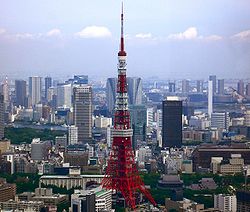
Back Opkoms van Japan as Wêreldmoondheid Afrikaans المعجزة الاقتصادية اليابانية Arabic Yapon iqtisadi möcüzəsi Azerbaijani Японско икономическо чудо Bulgarian Japonský hospodářský zázrak Czech Ιαπωνικό οικονομικό θαύμα Greek Milagro económico japonés Spanish Japoniako mirari ekonomikoa Basque معجزه اقتصادی ژاپن Persian Japanin talousihme Finnish
This article needs additional citations for verification. (February 2021) |
| Part of a series on the |
| History of Japan |
|---|
 |
The Japanese economic miracle (Japanese: 高度経済成長, romanized: Kōdo keizai seichō) refers to a period of economic growth in the post–World War II Japan. It generally refers to the period from 1955, around which time the per capita gross national income of the country recovered to pre-war levels,[1] and to the onset of the 1973 oil crisis.
Before the war, Japan had achieved industrialisation from the second half of the 19th century, but light industry and agriculture remained the backbone of the economy, and poverty was widespread among the working class and peasants.[2] Heavy industry was primarily focused on the military, such as aviation, shipbuilding, and military vehicles, rather than the production of civilian goods.[3] The Second World War resulted in the loss of all its colonial possessions, and both the mainland's industrial capabilities and population were heavily damaged. After the war, the government was deep in debt, while the people suffered privation of vital supplies, which inevitably caused hyperinflation.[4]
Under the Allied Occupation Forces, Japan's economy underwent significant structural changes, which initially included the dissolution of all major zaibatsu and the weakening of heavy industries and scientific research, so as to deprive the country of the ability to wage war ever again. The government and the Bank of Japan had to deal with hyperinflation while rebuilding the economy under these restrictions.[4] However, along with West Germany, Japan later benefited from a fundamental shift in US policy, which now tried to help rebuild these former enemies in a democratized form, rather than weakening them, in an effort to prevent the spread of communism in their respective regions.[5]
Japan's economy gradually recovered to regain pre-war standard of living towards the mid-1950s, around which time the 'economic miracle' started.[1] During this period, Japan's economic growth was driven by its heavy industries and the expansion of the middle class, which provided both a large domestic consumer market and bank savings. These savings were, in turn, lent to companies to invest in fixed capital.[6] The Japanese government's interventionism also played a role, most notably through the Income Doubling Plan, conceived by Osamu Shimomura and implemented by prime minister Hayato Ikeda. Japan also benefited from the Bretton Woods system, which pegged major currencies, including the yen, to the United States dollar.[1] During the economic boom, Japan rapidly became the world's third-largest economy, after the United States and the Soviet Union. Japan joined the OECD as an early member in the 1960s, and became a founding member of the G7. By the 1970s, Japan was no longer expanding as quickly as it had in the previous decades despite per-worker productivity remaining high.
- ^ a b c "第2章 産業調整をみる視点 - 内閣府". 内閣府ホームページ (in Japanese). Retrieved 3 March 2025.
- ^ Ryoshin, Minami (May 2007). "所得分布の戦前と戦後を振り返る" (PDF). Japan Labour Research Journal. 562. Japan Institute for Labour Policy and Training: 33.
- ^ Yamashita, Mitsuru (June 2022). "産業構造の変化と働き方" (PDF). Japan Labour Research Journal (in Japanese). 743. Japan Institute for Labour Policy and Training: 5.
- ^ a b Ito, Masanao (January 2012). "戦後ハイパー・インフレと中央銀行" (PDF). 金融研究 (1). Bank of Japan: 181.
- ^ "Political and Economic Changes during the American Occupation of Japan". Columbia University.
- ^ "昭和50年 年次経済報告 新しい安定軌道をめざして 第II部 新しい安定経済への道". www5.cao.go.jp. Retrieved 3 March 2025.
© MMXXIII Rich X Search. We shall prevail. All rights reserved. Rich X Search